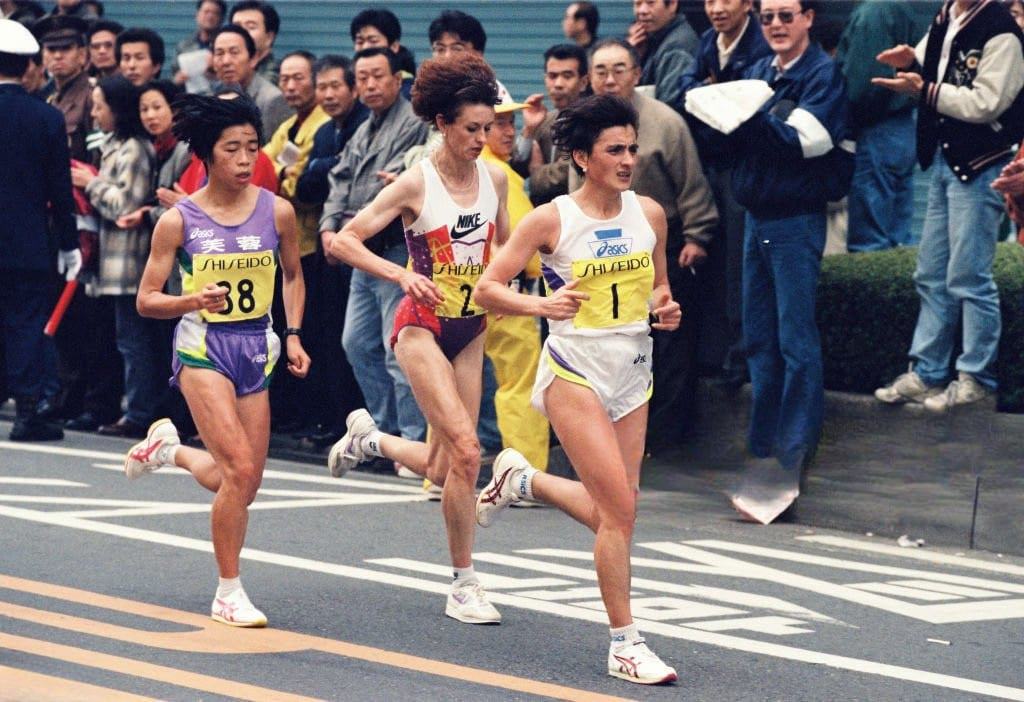If you know a bit about Australian marathon history, you will recall that Lisa Ondieki is our only Olympic marathon medallist. Her silver medal in Seoul in 1988 behind the great Rosa Mota is the only medal attained by an Australian at the Olympics. Robert de Castella and Steve Moneghetti share the highest place by an Australian male with fifth in 1984 and 1988 respectively.
Dig a little deeper and you will discover that at the start of the Seoul Olympic year Ondieki (she was Lisa Martin then) set an Australian record 2:23:51 in winning the Osaka women’s marathon, a record which stood for just short of 19 years until Benita Willis broke it in 2006 and which was further improved by Sinead Diver.
What you may not have known, however, is that Ondieki’s performance was regarded by some as a world record.
How so, you ask, given that Ingrid Kristiansen, Joan Benoit and Mota had all run faster: Kristiansen held the world best with her 2:21:06 in London in 1985. The reason why many of us back then thought of Ondieki’s time as a world record was that it was set in a women’s race on a loop course while the others were run in mixed fields in London and Chicago. Furthermore, because the London race started in Blackheath and ended on London Bridge (it’s much the same now except it finishes on The Mall), it was regarded as point-to-point.

Although many famous traditional marathons – Boston, London’s earlier Windsor to Chiswick course on which Jim Peters set three world bests – were point-to-point, as the marathon moved to official world record status loop or out-and-back courses were the only ones accepted as world-record or world-best-eligible. That’s changed now, with the requirement being that the start and finish do not have to be at the same point but can be separated by no more than half-the distance. By amazing coincidence, that made London and New York record-eligible! Boston, which is by no means a fast course, is not.
The relatively short history of women’s marathoning was given impetus not by the marathon’s adoption as a championship race, but rather by the gradual entry of women into mass participation races. Going way back, some pioneers were allowed to start before the men in some of the traditional races. Others ran by subterfuge. Roberta Gibb snuck into the Boston field one year then Kathy Switzer obtained an official bib by entering as ‘K.Switzer.’ The 1982 European championships staged a women’s marathon – won by Mota – Grete Waitz won the first world championships race in Helsinki in 1983 and Benoit triumphed in the first women’s Olympic marathon in Los Angeles in 1984.
When the International Amateur Athletic Association (now World Athletics) adopted world records for the marathon it recognised that most women’s performances came in mixed mass-participation races so it made no sense to deem such performances ineligible for record purposes. The official women’s world record is that thunderclap 2:09:56 by Ruth Chepngetich in Chicago last year. But World Athletics does still give recognition to the best performance in women-only competition.

That record stood at 2:16:16 to Peres Jepchirchir, set in London last year. Paris Olympic silver medallist Tigst Assefa won this year’s London in 2:15:50, beating Joyciline Jepkosgei and Olympic champion Sifan Hassan.
London has made something of a specialty of the women-only world record since race organisers generously allowed Paula Radcliffe a shot at world record bonus payments following her 2:15:25. The last four improvements have all come in London, Radcliffe winning again in 2:17:42 in 2005, Mary Keitany leaving the pacemakers and everyone else behind with her 2:17:01 in 2017 before Jepchirchir and Assefa in the past two years.
The concept of a women’s world record set in women-only races is well worth preserving replicating, as it does, what happens in championship racing. And the quality of the record-holders is undeniable dating back to Lisa Ondieki’s Olympic silver medal credentials. Paula Radcliffe was a world record breaker. She won the Helsinki 2005 world championship from defending champion Catherine Ndereba. Peres Jepchirchir is the Tokyo Olympic champion and Tigst Assefa was runner-up in Paris last year and set the previous world record at 2:11:53 in 2023.
There’s no mugs among that lot.
Another world best also caught the eye last weekend. That was the 33.05 for 300 metres hurdles set by 4000 hurdles world record holder Karsten Warholm in the opening Diamond League in China.

That’s pretty good. In fact, it’s better than the previous world best of 33.26 set by – checks notes – well, it was Warholm in 2021. That was in Oslo’s Bislett Stadium (but not the Oslo DL) in a warm-up for his 46.70 world record 400 hurdles when the DL meeting did take place a few weeks later. A diligent correspondent for the Athletics International newsletter did put together a world-time list which went all of seven places deep and all the way to a David Hemery (1968 Olympic champ) in London in 1972. For all intents and purposes, though, the history of the 300 hurdles is pretty much the history of Warholm’s participation.
So, it’s with some surprise you read a report that World Athletics will be granting the time-honoured ‘300 sticks’ world record status. Seems like an idea dreamed up on a quiet day in the innovations department. Anyway, as noted, Warholm went on to break the 400 hurdles world record in his very next race back in 2021 which should make his debut over the full lap in the second China DL in Shanghai/Keqiao this weekend (3 May) very interesting indeed.